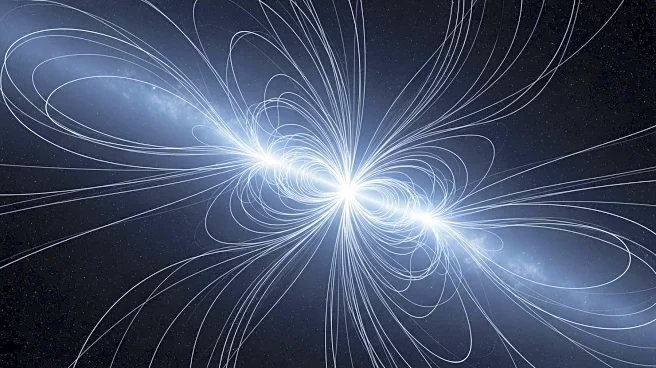What's Happening?
Researchers have identified a strange gravity signal detected by the GRACE satellites nearly 20 years ago, suggesting significant geological activity deep within the Earth. The anomaly, which lasted for about two years, was located off the coast of Africa and peaked in January 2007. This gravitational anomaly coincided with a geomagnetic 'jerk,' an abrupt change in Earth's magnetic field. The study, published in Geophysical Research Letters, proposes that a shift in minerals caused a rapid redistribution of mass in the deep mantle, near the Earth's core, altering the magnetic field. The GRACE satellites, a joint mission between NASA and the German Aerospace Center, were used to measure variations in Earth's gravity by tracking the distance between two identical spacecraft. The anomaly stretched approximately 4,350 miles, close to the length of the African continent, from 2006 to 2008.
Why It's Important?
The discovery of this gravity signal is significant as it provides insights into the complex processes occurring deep within the Earth. Understanding these processes is crucial for geophysics, as they can affect Earth's magnetic field and potentially influence global navigation systems reliant on magnetic data. The findings highlight the importance of using diverse datasets and methods to study Earth's interior, which remains largely mysterious. This research could lead to advancements in predicting geological events and understanding the planet's evolution. Stakeholders in scientific research and environmental monitoring stand to gain from these insights, which could improve models of Earth's internal dynamics.
What's Next?
Further research is needed to validate the findings and explore the implications of the mass redistribution in Earth's mantle. Scientists may conduct additional studies using newer satellite data and advanced modeling techniques to better understand the geological processes at play. The study's co-author, Mioara Mandea, emphasizes the need for continued exploration of Earth's deep interior using complementary methods. This could lead to more accurate predictions of geomagnetic changes and enhance our understanding of Earth's geological history.
Beyond the Headlines
The study underscores the complexity of Earth's internal systems and the need for interdisciplinary approaches to uncover hidden processes. The transformation of minerals in the mantle, such as the shift from perovskite to post-perovskite, highlights the dynamic nature of Earth's geology. These findings may have long-term implications for understanding seismic activity and the stability of Earth's magnetic field, which is vital for technological systems and ecological balance.











